English
Castellano
Català
A Forgotten Mineral Treasure - The Phalaborwa Complex
Author: Allan Fraser
Content by courtesy of : Online minerals
Reproduction of text and photos prohibited without permission of author.
The author recently obtained a number of mineral specimens from the Phalaborwa Mine and since then has have been fascinated by the beauty, variety and complexity of the minerals from this locality. During the 1980s, John Gliddon, a geologist at Phalaborwa mine amassed a large collection of zeolites, sulphides and a host of rare minerals from the open pit. However, after he left the mine, mineral specimens coming out this locality virtually ceased. Gliddon reports in the Mineralogical Record (5.) attractive specimens of zeolites and related minerals have been found lining some of the cavities in dykes cutting across the Phalaborwa open pit. These must be some of the most attractive zeolitic specimens yet reported from Africa, a continent not noted for their occurrence
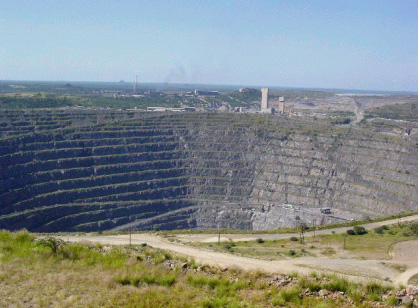
Figure 1: The open pit mine at Phalaborwa as it is today (April 2004). Mining in the open pit ceased a few years back and in 2000 shaft mining started. The dolerite dykes can just be seen as dark grey intrusions crisscrossing the deposit.
The formation of the Phalaborwa Complex is as fascinating as its mineral assemblage. Geologists tell us that around 2 billion years ago a carbonate rich magma intruded the granitic country rock welling up along fissures. The intrusion created a pipe-like complex largely concentrically arranged consisting of mainly pyroxenite, syenite and carbonatite. The intrusion occurred in several stages, with the pyroxenite interacting with the country rock forming a felsphathic pyroxenite along the area of contact between the two different rock masses (3) It seems that several plugs of syenite was also injected into the granite. This was followed by the formation of a course-grained pegmatoid emplaced in the pyroxenite. Additionally, a breccia-like rock, called phoscorite and banded carbonatite were emplaced within the central pegmatoid (3) Copper mineralization took place later via ascending fluids (1.) The Phalaborwa Complex is unique in that it is the only economically viable carbonatite-hosted copper deposit in the world(4) Inclusions studied in apatite from phoscorite and pyroxene found in the pyroxenite of the southern core of the Palaborwa Complex bear portlandite, sulfates, and fluorite, whose action as fluxing components explains the origin of the low-temperature carbonatite magmas, even at moderate contents of alkalis (2.) There is a network of dolerite dykes crosscutting the intrusive rocks of the Complex. The important role of water is highlighted by the occurrence of zeolites in the crystalline inclusions found in the dolerite dykes (2.) The age of the dykes is of Waterberg age (1.6 billion years) and varies in width and depth from a few centimeters to 50 meters (5.)
More than 50 different minerals have been reported from the Palaborwa Mine (excluding trace minerals) (1.) A variety of minerals are found within the intrusive rocks and the dolerite dykes hosting secondary minerals such as zeolites. A range of secondary minerals found in the dykes includes, analcime, biotite, calcite, chabazite, datolite, flourapophyllite, heulandite, lamontite, mesolite, natrolite, pectolite, prehnite, pyrite, saponite, scolecite, stilbite and thomsonite(5) A number of rare and exotic minerals have been found in the complex and a few of these include, iowaite, zirkelite, baddeleyite, chondrodite, antigorite and valleriite.
Below are featured several mineral specimens from the authors collection. These are meant to be an introduction to some of the minerals and by no means a complete representation or study of the minerals of the Phalaborwa Complex. Perhaps the sharing of this information will be a catalyst in renewed interest in this locality.
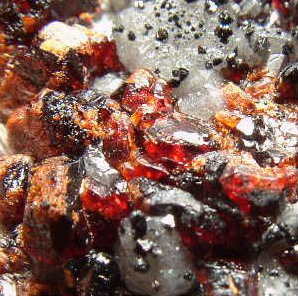
Figure 2: A flat calcite and chondrodite matrix is amply covered with rich red chondrodite crystals to 4mm across. A secondary dusting of minute magnetite and antigorite covers the later crystallisation of the chondrodite making it appear black. Field of view: 2x2cm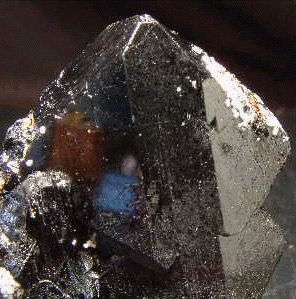
Figure 3: A single partially twinned section of magnetite crystal. There is minor calcite, attached with chondrodite and deep turquoise coloured iowaite. The magnetite is reported to be the largest ever (according to the original John Gliddon specimen label) collected at Phalabora. Specimen size: 3x4cm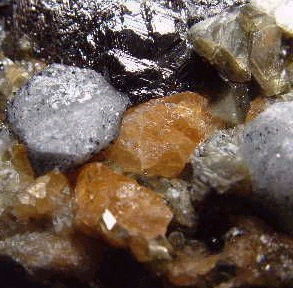
Figure 4: Good crystallisation of magnetite with associated calcite, gemmy green clinochlore and orange chondrodite. Also present are tiny secondary magnetite crystals and a few minute purple fluorites. The largest exposed chondrodite is 8mm, the orange colour is very unusual for the locality. Field of view: 2x2cm
Figure 5: A white carbonate matrix has a thin surface coat of calcite with bronze gold coloured phlogopite (?) or biotite and dispersed green single iowaite crystals and magnetite. Specimen size: 5x4cm.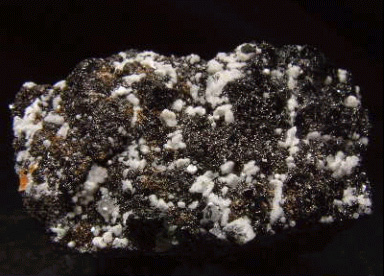
Figure 6: A flat parallel -terminated growth of magnetite has a surface dusting of fine crystals of valleriite, calcite and green clinochlore. Specimen size: 4x2.5cm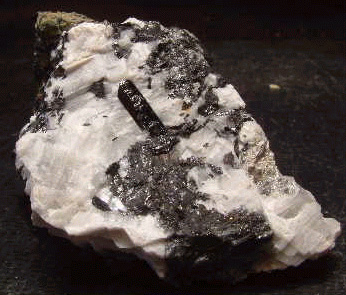
Figure 7: A piece of massive baddeleyite with calcite that has several baddeleyite crystals grown through. An excellent terminated 1cm crystal is exposed on one side of the matrix. Specimen size: 6x4cm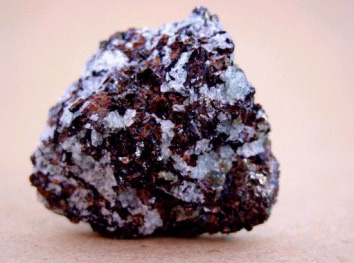
Figure 8: Hexagonal dark red crystals of phlogopite with pale green apatite. Specimen size: 4x3cm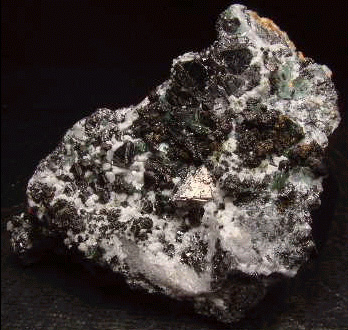
Figure 9: Crystallised valleriite on a matrix with magnetite, minor chondrodite and clinochlore. Specimen size: 6x4cm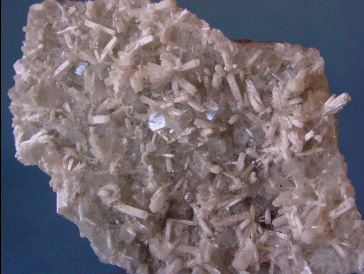
Figure 10: Silky slender crystals of mesolite with pale green flourapophyllite. Specimen size: 8x6cm
REFERENCES
1.The Minerals of South Africa, Bruce Cairncross and Roger Dixon, page 110
2.Inclusions in Minerals of the Palaborwa Carbonatite Complex, South Africa,I. P. Solovova *, I. D. Ryabchikov *, L. N. Kogarko **, and N. N. Kononkova **
3.South African Geology, J. Lurie, 8th Edition
4.The Mineral Resources of South Africa, Edited by M.G.C Wilson and C.R. Anhaeusser,6th Edition, page 213
5.The Mineralogical Record, Vol. 22. No. 4 July-August 1991, page 257 - 261
Content by courtesy of :
Information | Mineral photos | VIDEOS | Articles | Fairs | Web directory | Classified ads | Minerals Books | Shop



